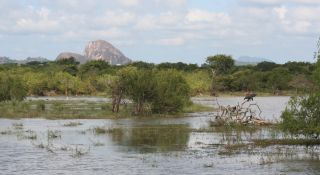
Elephant Rock & wetlands in Yala National Park
|
Flora & Fauna Areas Sri Lanka Flora/Fauna Related Pages Sri Lanka HomeSri Lanka Letters Sri Lanka Cruising |
Sri Lanka Animals
What a fantastic place Sri Lanka is for seeing many of the wild animals of the Indian Sub-continent! This island-country off the southeastern coast of India is home to Asian elephants, leopards, monkeys, mongoose, sloth bears, jackals, Sambar and chital deer, water buffalo and wild boars. Reptiles and amphibians include crocodiles and venomous snakes such as kraits, vipers and cobras, plus the more friendly geckos, frogs, and lizards. Birdlife is extraordinary (and we've given birds their own web pages). Unfortunately, of the more than 80 species of mammals in Sri Lanka, at least 22 are threatened with extinction. Habitat destruction by deforestation and water pollution is the main threat to these animals. The on-going civil war has led to more destruction especially in the north where rebels have poached animals for food.
 Elephant Rock & wetlands in Yala National Park |
As we traveled by rail and road throughout the Sri Lankan hills and along the coast we saw troops of wild macaque monkeys, numerous birds (especially water birds in the marshes), working elephants in the fields, and domesticated water buffalo. The best animal viewing, however, was in Yala National Park on the southeastern coast of the country. One of about 10 major national parks, Yala is particularly accessible to travelers and has not had the problem with poaching that some of the more northern parks have had due to the on-going civil war. Visitors to the parks contribute much-needed revenue and play a vital role in helping spread the word about the Sri Lanka's vast and varied wildlife.
Birding is excellent in the hills, and around the lagoons, marshes and waterways of the coast, and certainly in Yala National Park with its dry scrub, rivers, and wetlands.
Photos were all taken in Yala National Park by Amanda Hacking, unless otherwise noted. All text and photographs are copyrighted.
MAMMALS
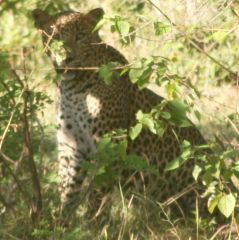 Leopard hiding behind brush |
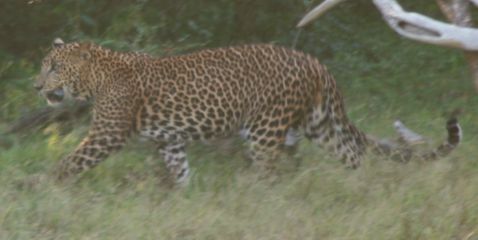 Leopard stalking a water-buffalo, but he didn't try very hard |
At about 5pm, just an hour before sunset, we were rewarded with a sighting of a Sri Lankan Leopard Pantera pardus kotika in Yala National Park. With only about 35 leopards here, it was quite thrilling! We first saw him (or her) in the bushes by the side of the road where another 4WD vehicle had stopped. We tried to get a photo, but couldn't. The leopard began walking west through the bush, and then, before the other vehicles moved, our driver backed up and took a side track hoping to intersect the leopard on its path. He was right on! We watched as this beautiful animal hid in the bushes (left), keeping us in view, then ambled across the dirt road to the edge of a pond. Spotting a water buffalo ahead, it put on a burst of speed (photo right), but didn't pursue for long. Instead, it decided to climb a huge tree and drape itself over the branches, four legs and long tail swinging freely. Then, with a bit of hesitation but skill it descended the tree head first and walked sedately back into the brush. Fantastic! We had over a half an hour of leopard watching! Sri Lanka's leopards are endemic to the island and are listed by the World Conservation Union as threatened.
| Even seen from afar, the brown, shaggy bulky body of the Sambar Deer Cerbus unicolor stag (right) is unmistakable. Here, a stag with antlers rests in a field in Yala National Park. Active at night, the deer are often seen resting near water during the day. Males develop antlers each year prior to rutting season in November or December. They perform ritualistic fights with other males. Mature females, called hinds, lead groups of 10 to 20 deer. These large deer stand 1 to 1.5m (40 to 63in) at the shoulder and can weigh up to 270 kg (600 lbs). |
 |
|
Sri Lanka's other deer is the graceful, light reddish-brown and white-spotted Chital Deer aka Axis Deer Axis axis. These lovely animals look like big versions of Bambi -- in other words they look like large fawns of deer from the Americas! The Chital deer congregate in groups of 20 of 30 animals but unlike the Sambar Deer, the group usually includes 2 or more adult males (see left). They tend to graze in open forest or on the edges of forest and grassland. |
|
 |
Trotting about the edges of marshes and across fields, families of Wild Boars Sus scrofa are a common sight in the national parks of Sri Lanka. These animals are similar to the European wild boars, but less hairy. Both males and females can carry short, strong tusks which they use for defense and for digging. Boars are omnivorous, eating roots, nuts, fruits and even small animals. They can weigh over 150 kg (330 lbs). |
 |
|
Omnipresent in Sri Lanka are the inquisitive, playful,
always-hungry, opportunistic Red Faced Macaques Macaca spp.
They can be found around homes, temples, shopping centers, roadsides and
in their more natural state in the wildlife sanctuaries. Like
other macaques, these monkeys have differentiated thumbs, cheek pouches
for storing food and hardened bare patches on their rumps called
callosities. Red Faced Macaques adults can grow to about 1m (39in)
long with a tail of equal length which they use for balance and as a
fifth limb to help when climbing or walking tree limbs or wires.
They have reddish faces and and overall tan/cream colored fur with
pointed black ears. Macaques are omnivorous and can be found near
garbage dumps or begging junk food from drivers by the road. In
the wild they eat leaves, berries and small animals. Living in
troops ranging from a few to many animals, both the males and females
have important roles such as keeping watch or caring for the young,
depending on their dominance. Often while the females care for
newborns males will watch over the older youth. Increased association with humans has led these intelligent animals to mimic human behavior and to become brazen in snatching food, hats, cameras and other unattended items. A bite by a macaque can be quite dangerous not only for bacteria but the possibility of rabies. It is best to guard your food and personal items closely when around the monkeys but if they start to take food, do not snatch it away or tease the animal. |
|
| The Indian Mongoose Herpestes edwardsi is a sleek, fast-moving predator. Hunting either alone or occasionally in pairs, the mongoose eats birds, snakes, eggs, frogs, small mammals and even fruit. Mongoose hunt by either day or night, and can usually be seen as they run, or almost slither across a road or other open space. They have a thick coat of speckled gray hair, a long muzzle and tail, and a mouth full of strong, sharp teeth. They do attack even the most poisonous of snakes such as the cobra, but they are not immune to the venom. Instead they use incredible agility to avoid being bitten. They live about 7 to 12 years and have litters of up to four young. |
|
|
Not nearly as ferocious as their African cousin, the Cape Buffalo, Sri Lanka's Water Buffalo Bubalus bubalis can still be dangerous when provoked. With their wide, splayed hooves good for walking in marshes and mud, they can be found just about anywhere there is water. These animals have been domesticated throughout Asia, and for millennia have been used for plowing and milk production. They can attain 1.8m (6 feet) at the shoulder, and are larger and more powerful than cattle. Water buffalo co-exist happily with several small birds such as the cattle egrets (right) and some small herons which hitch rides on their backs and remove ticks from their skin. (Photo right, Christopher Hacking) |
|
REPTILES
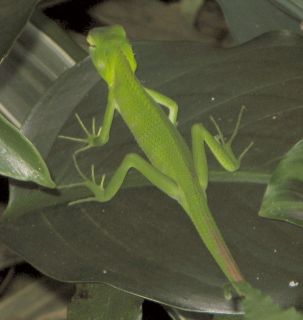 To the right is an unidentified little green lizard we found in the
Botanical Garden near Kandy. Anyone know what it is, or anything
about it? We have no ID book for small reptiles.
To the right is an unidentified little green lizard we found in the
Botanical Garden near Kandy. Anyone know what it is, or anything
about it? We have no ID book for small reptiles.Not so hard to ID, though, is the large Mugger or Swamp Crocodile Crocodylus palustris (left) which can be found, if you look closely, on the edges of lakes, marshes and wetlands throughout the country. Blending easily into the brown mud or grasslands, this inland crocodile spends part of its day in the freshwater and part in the sun. Not as large as the Indo-Pacific or Saltwater crocodile which inhabits the sea coasts of Australia and Asia, the Mugger is still a formidable predator. Swamp crocodiles feed on birds, amphibians, and small mammals such as young deer. During mating season they become quite sociable and you might see a lot of them draped all over each other. Apparently they are capable of traveling long distances to find water if their current pond or marsh dries up. They're not something you'd want to stroll along the road with! |
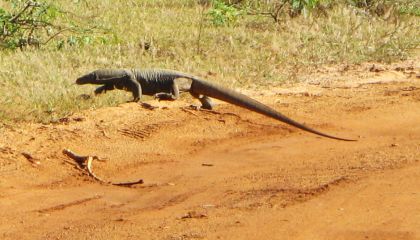
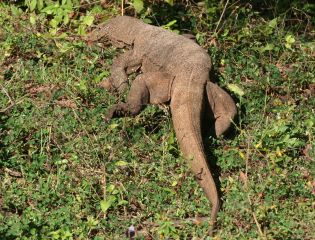 Ambling across the red dirt road in Yala National Park was one very large
reptile, which we quickly identified as Sri Lanka's Land Monitor
(not yet sure of the Latin name). There are about 30 species
of monitors, including the world's largest, the Komodo Dragon of Indonesia.
Smaller than the Komodo, Sri Lanka's monitor can climb trees. All monitors run
fast in pursuit of prey, which include small mammals, reptiles, insects, birds and carrion.
A long split tongue (visible in the photo to the left, by Jon Hacking) is used to
sense/smell prey. We estimated the length of this monitor to be about 2m (6.5ft).
Ambling across the red dirt road in Yala National Park was one very large
reptile, which we quickly identified as Sri Lanka's Land Monitor
(not yet sure of the Latin name). There are about 30 species
of monitors, including the world's largest, the Komodo Dragon of Indonesia.
Smaller than the Komodo, Sri Lanka's monitor can climb trees. All monitors run
fast in pursuit of prey, which include small mammals, reptiles, insects, birds and carrion.
A long split tongue (visible in the photo to the left, by Jon Hacking) is used to
sense/smell prey. We estimated the length of this monitor to be about 2m (6.5ft). |
Top Level: Home | Destinations | Cruising Info | Underwater | Boat Guests | Ocelot | Sue | Jon | Amanda | Chris | Site Map | Make a Comment
|
If our information is useful, you can help by making a donation |
Copyright © 2000‑ Contact: Jon and Sue Hacking -- HackingFamily.com, svOcelot.com. All rights reserved.